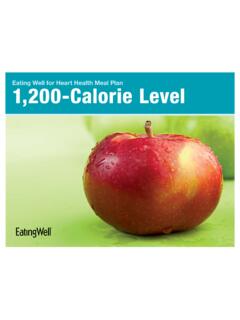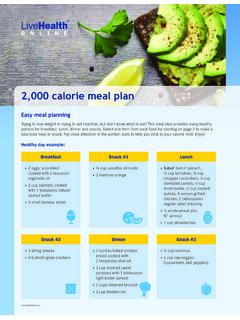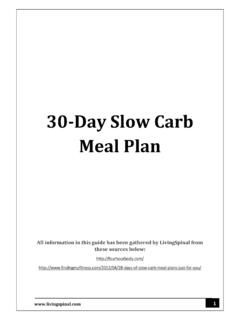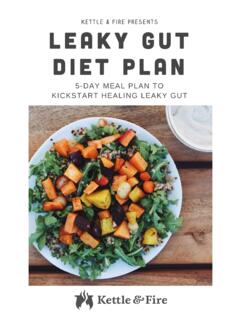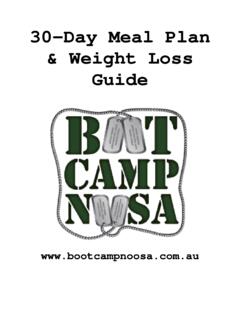Transcription of DAILY DIABETES MEAL PLANNING GUIDE
1 DAILY DIABETES MEAL PLANNING GUIDEA DAILY meal plan is an important part of your DIABETES management, along with physical activity, blood sugar (glucose) checks, and, often, DIABETES is no ideal meal plan that works for everyone with DIABETES . This GUIDE provides you with a variety of information that may help you plan your meals : BALANCE YOUR PLATE: Many people with DIABETES like to keep meal PLANNING simple. This eating plan can help you easily portion out your food A HANDY GUIDE TO PORTION SIZES: Quick tips for estimating portion sizes FOOD LISTS FOR MEAL PLANNING : Use this tool to help you figure out how many carbohydrates, proteins, and fats are a good amount for you CARBOHYDRATE COUNTING: There are many foods with carbohydrates you can still enjoy, including grains, fruits, vegetables, milk products, and even some food choices with sugar.
2 Carbohydrates raise your blood sugar level more than proteins and fats. Learn how to track the carbohydrates you eat in your meals and snacksDIETARY GUIDELINES AT A GLANCE: Balance your calories to manage your weight Increase your intake of nutrient-dense foods, such as fruits, vegetables, whole grains, low-fat dairy and protein, and healthy fats/oils Reduce your intake of sodium, fats, added sugars, refined grains, and alcohol Build healthy eating patternsChecking your blood sugar as directed by your healthcare provider will help you to see how your food choices affect your blood sugar. It can also help you determine where adjustments may be registered dietitian (RD) can help you make a meal plan that best meets your needs and lifestyle.
3 Ask your healthcare provider, certified DIABETES educator (CDE), hospital, or local DIABETES association for the names of RDs in your area who work with people who have DIABETES , or search for an RD online at us at PLANNING OPTIONSA HANDY GUIDE TO PORTION SIZES*: MyPlate is not customized to match an individual's carbohydrate needs and blood sugar goals. It's still important to see an RD or CDE for nutrition advice. FRUITS: A serving of fruit is 1 small fresh fruit, 2 tbsp dried fruit, or cup canned fruit or 4 oz unsweetened fruit juice VEGETABLES: Choose nonstarchy vegetables, such as broccoli, carrots, cauliflower, or green beans GRAINS: Fill of the plate with a bread, cooked grain, or starchy vegetable, such as corn, brown rice, or potatoes.
4 Choose whole grains more often DAIRY: Add 1 cup fat-free/low-fat milk or / cup fat-free/low-fat/light yogurt PROTEIN: Fill this of the plate with lean meat, poultry, or fish. If you choose a plant-based protein, such as dried beans, remember to include the carbohydrate content as part of your total carbohydrate amount for the meal* Hand sizes vary. These portion estimates are based on a woman s hand size. Measuring or weighing foods is the most accurate way to figure out portion YOUR PLATE9 palm size, not including fingers and thumb, is about 3 ounces of cooked and boneless fist size is about 1 cup or about 30 grams of carbs for foods such as 1 cup ice cream or 1 cup cooked thumb size is about 1 tablespoon or 1 serving of regular salad dressing, reduced-fat mayonnaise, or reduced-fat size of your thumb tip is about 1 teaspoon, or 1 serving, of margarine, mayonnaise, or other fats or oils.
5 FOOD LISTS FOR MEAL PLANNING KEY * Foods marked with * should be counted as 1 starch + 1 fat per serving J Foods marked with J contain more than 3 grams of dietary fiber per serving ! Foods marked with ! contain 400 mg or more of sodium per servingoz= ouncetsp= teaspoontbsp= tablespoonAdapted from:The Official Pocket GUIDE to Diabetic Exchanges,American DIABETES Association, serving from this list contains 15 grams carbohydrate, 0-3 grams protein, 0-1 gram fat, and 80 of the calories in these foods come from carbohydrates, a good source of energy. Many foods from this group also give you fiber, vitamins, and minerals. Prepare and eat starchy foods with as little added fat as possible.
6 Choose whole grain starches when you general, a single serving of starch is: cup of cooked cereal, grain, or starchy vegetable 1/ cup of cooked rice or pasta 1 oz of a bread product (such as 1 slice of whole wheat bread) to 1 oz of most snack foods (some snack foods may also have extra fat)Bread Serving SizeBagel (large, about 4 oz) *Biscuit ( 2 inches across) 1 Bread (whole wheat, white, or rye) (1 oz) 1 slice*Cornbread (1 -inch cube or 1 oz) 1 English muffin Hot dog or hamburger bun (1 oz) Pancake (4 inches across, -inch thick) 1 Pita pocket (6 inches across) Roll (plain, small, 1 oz) 1 Tortilla (corn or flour, 6 inches across) 1*Waffle (4-inch square or 4-inch diameter)
7 1 Cereals and Grains Serving SizeCereals, cooked (oats, oatmeal) cupCereals (unsweetened, ready-to-eat) cupCouscous 1/ cupGranola (low-fat) cupPasta, cooked 1/ cupRice, cooked (white or brown) 1/ cupStarchy Vegetables Serving SizeCorn cupCorn on cob (large, 5 oz) cobJ Hominy, canned cupJ Peas, green cupPlantain, ripe 1/ cupPotatoBaked with skin (3 oz) 1 Boiled, all kinds (3 oz) cupFrench fried (oven-baked) (2 oz) 1 cup*Mashed with milk and fat cup! Spaghetti/red pasta sauce cupJ Squash, winter 1 cupYam, sweet potato, plain cupCrackers and Snacks Serving SizeCrackers *Round, butter-type 6 Saltines 6 Graham cracker (2 -inch square) 3J Popcorn*With butter 3 cupsLower fat or no fat added 3 cupsPretzels ozSnack chips (tortilla chips, potato chips) Fat-free or baked ( oz) 15-20 *Regular ( oz) 9-13 Beans, Peas, and Lentils(Count as 1 Starch + 1 Lean Meat) Serving SizeJ Baked beans 1/ cupJ Beans, cooked (black, garbanzo,kidney, lima, navy, pinto, white) cupJ Lentils, cooked (brown, green, yellow) cupJ Peas, cooked (black-eyed, split)
8 CupFRUITSEach serving from this list contains 15 grams carbohydrate, 0 grams fat, 0 grams protein, and 60 are good sources of fiber, regardless of whether they are fresh, frozen, or dried. Fruit juices contain very little fiber. Choose whole fruit instead of juices whenever possible. When using canned fruit, choose fruit packed in its own juice or light general, a single serving of fruit is: cup of canned or fresh fruit or 4 oz unsweetened fruit juice 1 small fresh fruit (4 oz) 2 tablespoons of dried fruitFruit Serving SizeApple, unpeeled (small, 4 oz) 1 Applesauce, unsweetened cupBanana (extra small, 4 oz) 1 Berries J Blackberries cup Blueberries cupJ Raspberries 1 cupJ Strawberries (whole) 1 cupCantaloupe (cubed) 1 cupCherries (sweet, fresh, 3 oz) 12 Dried fruits (blueberries, cherries, cranberries, mixed fruit, raisins) 2 tbspGrapefruit (large, 11 oz) Grapes (small, 3 oz) 17 Guava cupJ Kiwi (3 oz) 1 Mandarin oranges, canned cupMango (small, 5 oz) fruit or cupJ Orange (small, 6 oz) 1 Papaya (cubed, 8 oz)
9 Fruit or 1 cupPeaches (fresh, medium, 6 oz) 1 Pears (fresh, large, 4 oz) Pineapple (fresh) cupPlums (small) 2 Dried (prunes) 3 Watermelon (cubes, 13 oz) 1 slice or 1 cupsFruit Juice Serving SizeApple, grapefruit, orange, pineapple cupFruit juice blends (100% juice) 1/ cup Grape juice 1/ cupPrune juice 1/ cupMILKMilk and yogurt are rich in calcium and protein. Choose fat-free, low-fat, and reduced-fat varieties for health. They have less saturated fat and cholesterol than whole milk (skim) or low-fat (1%) milk and yogurt: Each serving from this list contains 12 grams carbohydrate, 8 grams protein, 0-3 grams fat, and 100 calories . Serving SizeMilk, buttermilk, acidophilus milk, Lactaid 1 cupEvaporated milk cupYogurt (plain or flavored with a low-calorie sweetener, 6 oz) / cupReduced-fat (2%) milk and yogurt: Each serving from this list contains 12 grams carbohydrate, 8 grams protein, 5 grams fat, and 120 calories .
10 Serving SizeMilk, acidophilus milk, Lactaid 1 cupYogurt (plain, 6 oz) 3/4 cup Whole milk and yogurt: Each serving from this list contains 12 grams carbohydrate, 8 grams protein, 8 grams fat, and 160 calories . Serving SizeMilk, buttermilk, goat s milk 1 cupEvaporated milk cupYogurt (plain, 8 oz) 1 cupDairy-like Foods Serving Size Chocolate milk (fat-free) 1 cup(1 fat-free milk + 1 carbohydrate)Chocolate milk (whole) 1 cup (1 whole milk + 1 carbohydrate)Smoothies (flavored, regular) 10 oz (1 fat-free milk + 2 carbohydrate)Soy milk (regular, plain) 1 cup (1 carbohydrate + 1 fat)Yogurt with fruit (low-fat, 6 oz) / cup (1 fat-free milk + 1 carbohydrate)NONSTARCHY VEGETABLESEach serving from this list contains 5 grams carbohydrate, 2 grams protein, and 25 calories .
